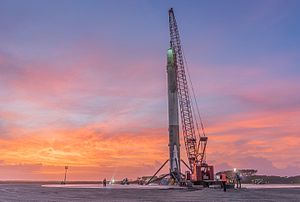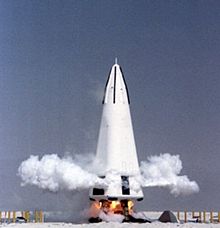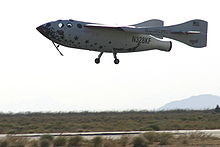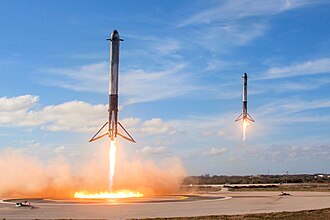|
Reusable launch vehicle
A reusable launch vehicle has parts that can be recovered and reflown, while carrying payloads from the surface to outer space. Rocket stages are the most common launch vehicle parts aimed for reuse. Smaller parts such as rocket engines and boosters can also be reused, though reusable spacecraft may be launched on top of an expendable launch vehicle. Reusable launch vehicles do not need to make these parts for each launch, therefore reducing its launch cost significantly. However, these benefits are diminished by the cost of recovery and refurbishment. Reusable launch vehicles may contain additional avionics and propellant, making them heavier than their expendable counterparts. Reused parts may need to enter the atmosphere and navigate through it, so they are often equipped with heat shields, grid fins, and other flight control surfaces. By modifying their shape, spaceplanes can leverage aviation mechanics to aid in its recovery, such as gliding or lift. In the atmosphere, parachutes or retrorockets may also be needed to slow it down further. Reusable parts may also need specialized recovery facilities such as runways or autonomous spaceport drone ships. Some concepts rely on ground infrastructures such as mass drivers to accelerate the launch vehicle beforehand. Since at least in the early 20th century, single-stage-to-orbit reusable launch vehicles have existed in science fiction. In the 1970s, the first reusable launch vehicle, the Space Shuttle, was developed. However, in the 1990s, due to the program's failure to meet expectations, reusable launch vehicle concepts were reduced to prototype testing. The rise of private spaceflight companies in the 2000s and 2010s lead to a resurgence of their development, such as in SpaceShipOne, New Shepard, Electron, Falcon 9, and Falcon Heavy. Many launch vehicles are now expected to debut with reusability in the 2020s, such as Starship, New Glenn, Neutron, Soyuz-7, Ariane Next, Long March, Terran R, and the Dawn Mk-II Aurora.[1] The impact of reusability in launch vehicles has been foundational in the space flight industry. So much so that in 2024, the Cape Canaveral Space Force Station initiated a 50 year forward looking plan for the Cape that involved major infrastructure upgrades (including to Port Canaveral) to support a higher anticipated launch cadence and landing sites for the new generation of vehicles.[2] ConfigurationsReusable launch systems may be either fully or partially reusable. Fully reusable launch vehicleSeveral companies are currently developing fully reusable launch vehicles as of March 2024. Each of them is working on a two-stage-to-orbit system. SpaceX is testing Starship, which has been in development since 2016 and has made an initial test flight in April 2023[3] and 5 more flights as of November 2024. Blue Origin, with Project Jarvis, began development work by early 2021, but has announced no date for testing and have not discussed the project publicly.[4] Stoke Space is also developing a rocket which is planned to be reusable.[5][6] As of October 2024[update], Starship is the only launch vehicle intended to be fully reusable that has been fully built and tested. The most recent test flight was on October 13, 2024, in which the vehicle completed a suborbital launch and landed both stages for the second time. The Super Heavy booster was caught successfully by the "chopstick system" on Orbital Pad A for the first time. The Ship completed its second successful reentry and returned for a controlled splashdown in the Indian Ocean. The test marked the second instance that could be considered meeting all requirements to be fully reusable.[7][failed verification – see discussion] Partially reusable launch systemsPartial reusable launch systems, in the form of multiple stage to orbit systems have been so far the only reusable configurations in use. Specific component reuseThe historic Space Shuttle reused its Solid Rocket Boosters, its RS-25 engines and the Space Shuttle orbiter that acted as an orbital insertion stage, but it did not reuse the External Tank that fed the RS-25 engines. This is an example of a reusable launch system which reuses specific components of rockets. ULA’s Vulcan Centaur was originally designed to reuse the first stage engines, while the tank is expended. The engines would splashdown on an inflatable aeroshell, then be recovered. On 23 February 2024, one of the nine Merlin engines a powering a Falcon 9 launched for the 22nd time, making it the most reused liquid fuel engine used in an operational manner, having already surpassed Space Shuttle Main Engine number 2019's record of 19 flights. Liftoff stagesAs of 2024, Falcon 9 and Falcon Heavy are the only orbital rockets to reuse their boosters, although multiple other systems are in development. All aircraft-launched rockets reuse the aircraft. Other than that a range of non-rocket liftoff systems have been proposed and explored over time as reusable systems for liftoff, from balloons[8][relevant?] to space elevators. Existing examples are systems which employ winged horizontal jet-engine powered liftoff. Such aircraft can air launch expendable rockets and can because of that be considered partially reusable systems if the aircraft is thought of as the first stage of the launch vehicle. An example of this configuration is the Orbital Sciences Pegasus. For suborbital flight the SpaceShipTwo uses for liftoff a carrier plane, its mothership the Scaled Composites White Knight Two. Rocket Lab is working on Neutron, and the European Space Agency is working on Themis. Both vehicles are planned to recover the first stage.[9][10] Orbital insertion stagesSo far, most launch systems achieve orbital insertion with at least partially expended multistaged rockets, particularly with the second and third stages. Only the Space Shuttle has achieved a reuse of the orbital insertion stage, by using the engines and fuel tank of its orbiter. The Buran spaceplane and Starship spacecraft are two other reusable spacecraft that were designed to be able to act as orbital insertion stages and have been produced, however the former only made one uncrewed test flight before the project was cancelled, and the latter is not yet operational, having completed four orbital test flights, as of June 2024, which achieved all of its mission objectives at the fourth flight. Reusable spacecraftLaunch systems can be combined with reusable spaceplanes or capsules. The Space Shuttle orbiter, SpaceShipTwo, Dawn Mk-II Aurora, and the under-development Indian RLV-TD are examples for a reusable space vehicle (a spaceplane) as well as a part of its launch system. More contemporarily the Falcon 9 launch system has carried reusable vehicles such as the Dragon 2 and X-37. Contemporary reusable orbital vehicles include the X-37, the Dream Chaser, the Dragon 2, the Indian RLV-TD and the upcoming European Space Rider (successor to the IXV). As with launch vehicles, all pure spacecraft during the early decades of human capacity to achieve spaceflight were designed to be single-use items. This was true both for satellites and space probes intended to be left in space for a long time, as well as any object designed to return to Earth such as human-carrying space capsules or the sample return canisters of space matter collection missions like Stardust (1999–2006)[11] or Hayabusa (2005–2010).[12][13] Exceptions to the general rule for space vehicles were the US Gemini SC-2, the Soviet Union spacecraft Vozvraschaemyi Apparat (VA), the US Space Shuttle orbiter (mid-1970s-2011, with 135 flights between 1981 and 2011) and the Soviet Buran (1980-1988, with just one uncrewed test flight in 1988). Both of these spaceships were also an integral part of the launch system (providing launch acceleration) as well as operating as medium-duration spaceships in space. This began to change in the mid-2010s. In the 2010s, the space transport cargo capsule from one of the suppliers resupplying the International Space Station was designed for reuse, and after 2017,[14] NASA began to allow the reuse of the SpaceX Dragon cargo spacecraft on these NASA-contracted transport routes. This was the beginning of design and operation of a reusable space vehicle. The Boeing Starliner capsules also reduce their fall speed with parachutes and deploy an airbag shortly before touchdown on the ground, in order to retrieve and reuse the vehicle. As of 2021[update], SpaceX is building and testing the Starship spaceship to be capable of surviving multiple hypersonic reentries through the atmosphere so that they become truly reusable long-duration spaceships; no Starship operational flights have yet occurred. Entry systemsHeat shieldWith possible inflatable heat shields, as developed by the US (Low Earth Orbit Flight Test Inflatable Decelerator - LOFTID)[15] and China,[16] single-use rockets like the Space Launch System are considered to be retrofitted with such heat shields to salvage the expensive engines, possibly reducing the costs of launches significantly.[17] Heat shields allow an orbiting spacecraft to land safely without expending very much fuel. They need not take the form of inflatable heat shields, they may simply take the form of heat-resistant tiles that prevent heat conduction. Heat shields are also proposed for use in combination with retrograde thrust to allow for full reusability as seen in Starship. Retrograde thrustReusable launch system stages such as the Falcon 9 and the New Shepard employ retrograde burns for re-entry, and landing.[citation needed] Landing systemsReusable systems can come in single or multiple (two or three) stages to orbit configurations. For some or all stages the following landing system types can be employed. TypesParachutes and airbagsThese are landing systems that employ parachutes and bolstered hard landings, like in a splashdown at sea or a touchdown at land. The latter may require an engine burn just before landing as parachutes alone cannot slow the craft down enough to prevent injury to astronauts. This can be seen in the Soyuz capsule. Though such systems have been in use since the beginning of astronautics to recover space vehicles, only later have the vehicles been reused. E.g.: Horizontal (winged)Single or main stages, as well as fly-back boosters can employ a horizontal landing system. These vehicles land on earth much like a plane does, but they usually do not use propellant during landing. Examples are:
A variant is an in-air-capture tow back system, advocated by a company called EMBENTION with its FALCon project.[18] Vehicles that land horizontally on a runway require wings and undercarriage. These typically consume about 9-12% of the landing vehicle mass,[citation needed] which either reduces the payload or increases the size of the vehicle. Concepts such as lifting bodies offer some reduction in wing mass,[citation needed] as does the delta wing shape of the Space Shuttle. Vertical (retrograde)Systems like the McDonnell Douglas DC-X (Delta Clipper) and those by SpaceX are examples of a retrograde system. The boosters of Falcon 9 and Falcon Heavy land using one of their nine engines. The Falcon 9 rocket is the first orbital rocket to vertically land its first stage on the ground. The first stage of Starship is planned to land vertically, while the second is to be caught by arms after performing most of the typical steps of a retrograde landing. Blue Origin's New Shepard suborbital rocket also lands vertically back at the launch site. Retrograde landing typically requires about 10% of the total first stage propellant, reducing the payload that can be carried due to the rocket equation.[19] Landing using aerostatic forceThere is also the concept of a launch vehicle with an inflatable, reusable first stage. The shape of this structure will be supported by excess internal pressure (using light gases). It is assumed that the bulk density of the first stage (without propellant) is less than the bulk density of air. Upon returning from flight, such a first stage remains floating in the air (without touching the surface of the Earth). This will ensure that the first stage is retained for reuse. Increasing the size of the first stage increases aerodynamic losses. This results in a slight decrease in payload. This reduction in payload is compensated for by the reuse of the first stage.[20] ConstraintsExtra weightReusable stages weigh more than equivalent expendable stages. This is unavoidable due to the supplementary systems, landing gear and/or surplus propellant needed to land a stage. The actual mass penalty depends on the vehicle and the return mode chosen.[21] RefurbishmentAfter the launcher lands, it may need to be refurbished to prepare it for its next flight. This process may be lengthy and expensive. The launcher may not be able to be recertified as human-rated after refurbishment, although SpaceX has flown reused Falcon 9 boosters for human missions. There is eventually a limit on how many times a launcher can be refurbished before it has to be retired, but how often a launcher can be reused differs significantly between the various launch system designs. HistoryWith the development of rocket propulsion in the first half of the twentieth century, space travel became a technical possibility. Early ideas of a single-stage reusable spaceplane proved unrealistic and although even the first practical rocket vehicles (V-2) could reach the fringes of space, reusable technology was too heavy. In addition, many early rockets were developed to deliver weapons, making reuse impossible by design. The problem of mass efficiency was overcome by using multiple expendable stages in a vertical launch multistage rocket. USAF and NACA had been studying orbital reusable spaceplanes since 1958, e.g. Dyna-Soar, but the first reusable stages did not fly until the advent of the US Space Shuttle in 1981. 20th century Perhaps the first reusable launch vehicles were the ones conceptualized and studied by Wernher von Braun from 1948 until 1956. The Von Braun Ferry Rocket underwent two revisions: once in 1952 and again in 1956. They would have landed using parachutes.[22][23] The General Dynamics Nexus was proposed in the 1960s as a fully reusable successor to the Saturn V rocket, having the capacity of transporting up to 450–910 t (990,000–2,000,000 lb) to orbit.[24][25] See also Sea Dragon, and Douglas SASSTO. The BAC Mustard was studied starting in 1964. It would have comprised three identical spaceplanes strapped together and arranged in two stages. During ascent the two outer spaceplanes, which formed the first stage, would detach and glide back individually to earth. It was canceled after the last study of the design in 1967 due to a lack of funds for development.[26] NASA started the Space Shuttle design process in 1968, with the vision of creating a fully reusable spaceplane using a crewed fly-back booster. This concept proved expensive and complex, therefore the design was scaled back to reusable solid rocket boosters and an expendable external tank.[27][28] Space Shuttle Columbia launched and landed 27 times and was lost with all crew on the 28th landing attempt; Challenger launched and landed 9 times and was lost with all crew on the 10th launch attempt; Discovery launched and landed 39 times; Atlantis launched and landed 33 times; Endeavour launched and landed 25 times. In 1986 President Ronald Reagan called for an air-breathing scramjet National Aerospace Plane (NASP)/X-30. The project failed due to technical issues and was canceled in 1993.[29] In the late 1980s a fully reusable version of the Energia rocket, the Energia II, was proposed. Its boosters and core would have had the capability of landing separately on a runway.[30] In the 1990s the McDonnell Douglas Delta Clipper VTOL SSTO proposal progressed to the testing phase. The DC-X prototype demonstrated rapid turnaround time and automatic computer control. In mid-1990s, British research evolved an earlier HOTOL design into the far more promising Skylon design, which remained in development until 2024 when the company developing Skylon went bankrupt. From the late 1990s to the 2000s, the European Space Agency studied the recovery of the Ariane 5 solid rocket boosters.[31] The last recovery attempt took place in 2009.[32] The commercial ventures, Rocketplane Kistler and Rotary Rocket, attempted to build reusable privately developed rockets before going bankrupt.[citation needed] NASA proposed reusable concepts to replace the Shuttle technology, to be demonstrated under the X-33 and X-34 programs, which were both cancelled in the early 2000s due to rising costs and technical issues. 21st century  The Ansari X Prize contest was intended to develop private suborbital reusable vehicles. Many private companies competed, with the winner, Scaled Composites, reaching the Kármán line twice in a two-week period with their reusable SpaceShipOne. In 2012, SpaceX started a flight test program with experimental vehicles. These subsequently led to the development of the Falcon 9 reusable rocket launcher.[33] On 23 November 2015 the New Shepard rocket became the first Vertical Take-off, Vertical Landing (VTVL) sub-orbital rocket to reach space by passing the Kármán line (100 km or 62 mi), reaching 329,839 ft (100,535 m) before returning for a propulsive landing.[34][35] SpaceX achieved the first vertical soft landing of a reusable orbital rocket stage on December 21, 2015, after delivering 11 Orbcomm OG-2 commercial satellites into low Earth orbit.[36] The first reuse of a Falcon 9 first stage occurred on 30 March 2017.[37] SpaceX now routinely recovers and reuses their first stages, as well as reusing fairings.[38] In 2019 Rocket Lab announced plans to recover and reuse the first stage of their Electron launch vehicle, intending to use parachutes and mid-air retrieval.[39] On 20 November 2020, Rocket Lab successfully returned an Electron first stage from an orbital launch, the stage softly splashing down in the Pacific Ocean.[40] China is researching the reusability of the Long March 8 system.[41] As of May 2020[update], the only operational reusable orbital-class launch systems are the Falcon 9 and Falcon Heavy, the latter of which is based upon the Falcon 9. SpaceX is also developing the fully reusable Starship launch system.[42] Blue Origin is developing its own New Glenn partially reusable orbital rocket, as it is intending to recover and reuse only the first stage. 5 October 2020, Roscosmos signed a development contract for Amur a new launcher with a reusable first stage.[43] In December 2020, ESA signed contracts to start developing THEMIS, a prototype reusable first stage launcher.[44] Return to launch siteAfter 1980, but before the 2010s, two orbital launch vehicles developed the capability to return to the launch site (RTLS). Both the US Space Shuttle—with one of its abort modes[45][46]—and the Soviet Buran[47] had a designed-in capability to return a part of the launch vehicle to the launch site via the mechanism of horizontal-landing of the spaceplane portion of the launch vehicle. In both cases, the main vehicle thrust structure and the large propellant tank were expendable, as had been the standard procedure for all orbital launch vehicles flown prior to that time. Both were subsequently demonstrated on actual orbital nominal flights, although both also had an abort mode during launch that could conceivably allow the crew to land the spaceplane following an off-nominal launch. In the 2000s, both SpaceX and Blue Origin have privately developed a set of technologies to support vertical landing of the booster stage of a launch vehicle. After 2010, SpaceX undertook a development program to acquire the ability to bring back and vertically land a part of the Falcon 9 orbital launch vehicle: the first stage. The first successful landing was done in December 2015,[48] since then several additional rocket stages landed either at a landing pad adjacent to the launch site or on a landing platform at sea, some distance away from the launch site.[49] The Falcon Heavy is similarly designed to reuse the three cores comprising its first stage. On its first flight in February 2018, the two outer cores successfully returned to the launch site landing pads while the center core targeted the landing platform at sea but did not successfully land on it.[50] Blue Origin developed similar technologies for bringing back and landing their suborbital New Shepard, and successfully demonstrated return in 2015, and successfully reused the same booster on a second suborbital flight in January 2016.[51] By October 2016, Blue had reflown, and landed successfully, that same launch vehicle a total of five times.[52] It must however be noted that the launch trajectories of both vehicles are very different, with New Shepard going straight up and down without achieving orbital flight, whereas Falcon 9 has to cancel substantial horizontal velocity and return from a significant distance downrange, while delivering the payload to orbit with the second stage. Both Blue Origin and SpaceX also have additional reusable launch vehicles under development. Blue is developing the first stage of the orbital New Glenn LV to be reusable, with first flight planned for no earlier than 2024. SpaceX has a new super-heavy launch vehicle under development for missions to interplanetary space. The SpaceX Starship is designed to support RTLS, vertical-landing and full reuse of both the booster stage and the integrated second-stage/large-spacecraft that are designed for use with Starship.[53] Its first launch attempt took place in April 2023; however, both stages were lost during ascent. On the fourth launch attempt however, both the booster and the ship achieved a soft landing in the Gulf of Mexico and the Indian Ocean, respectively. List of reusable launch vehicles
List of reusable spacecraft
List of reusable suborbital vehicles
List updated 1 December 2024. See alsoReferences
Bibliography
External linksWikimedia Commons has media related to Reusable launch systems.
|
||||||||||||||||||||||||||||||||||||||||||||||||||||||||||||||||||||||||||||||||||||||||||||||||||||||||||||||||||||||||||||||||||||||||||||||||||||||||||||||||||||||||||||||||||||||||||||||||||||||||||||||||||||||||||||||||||||||||||||||||||||||||||||||||||||||||||||||||||||||||||||||||||||||||||||||||||||||||||||||||||||||||||||||||||||||||||||||||||||||||||||||||||||||||||||||||||||||||||||||||||||||||||||||||
